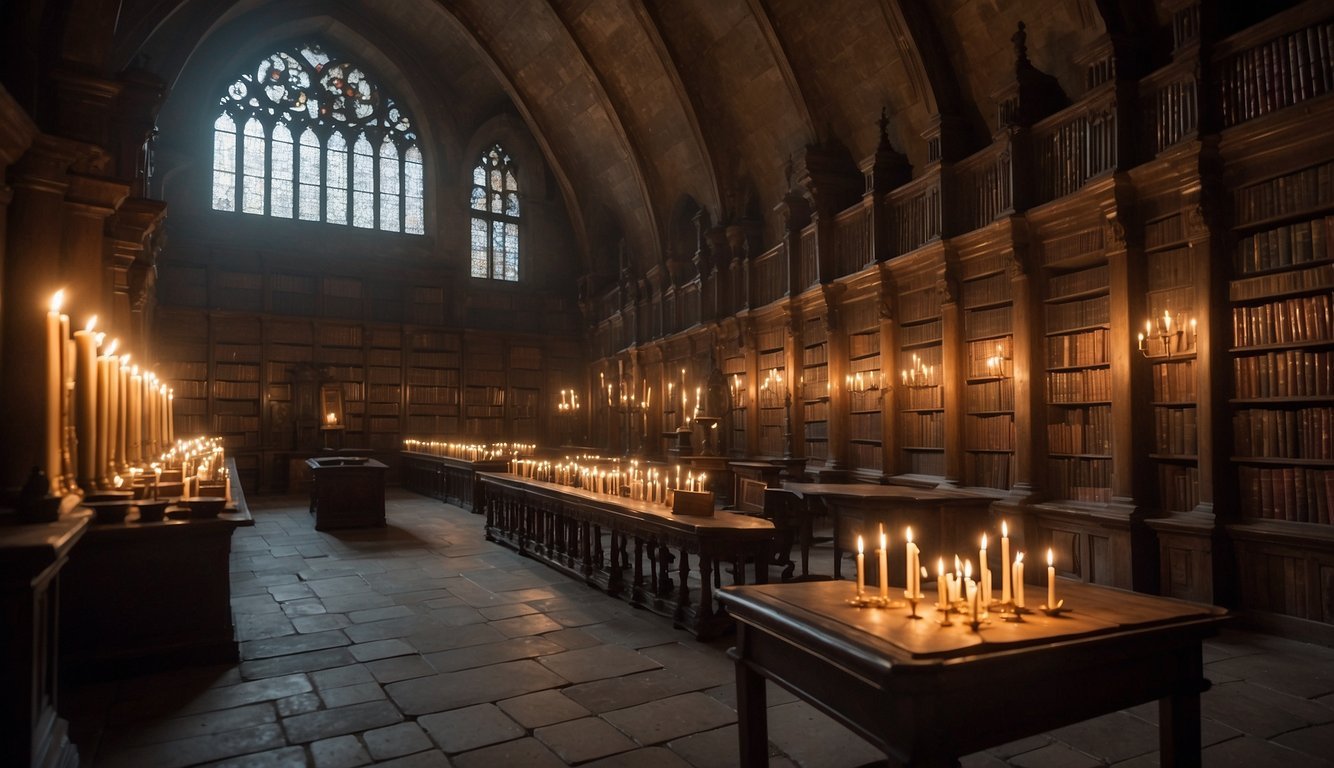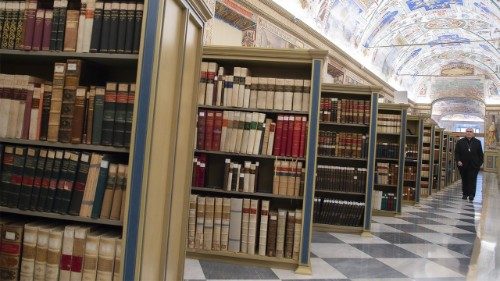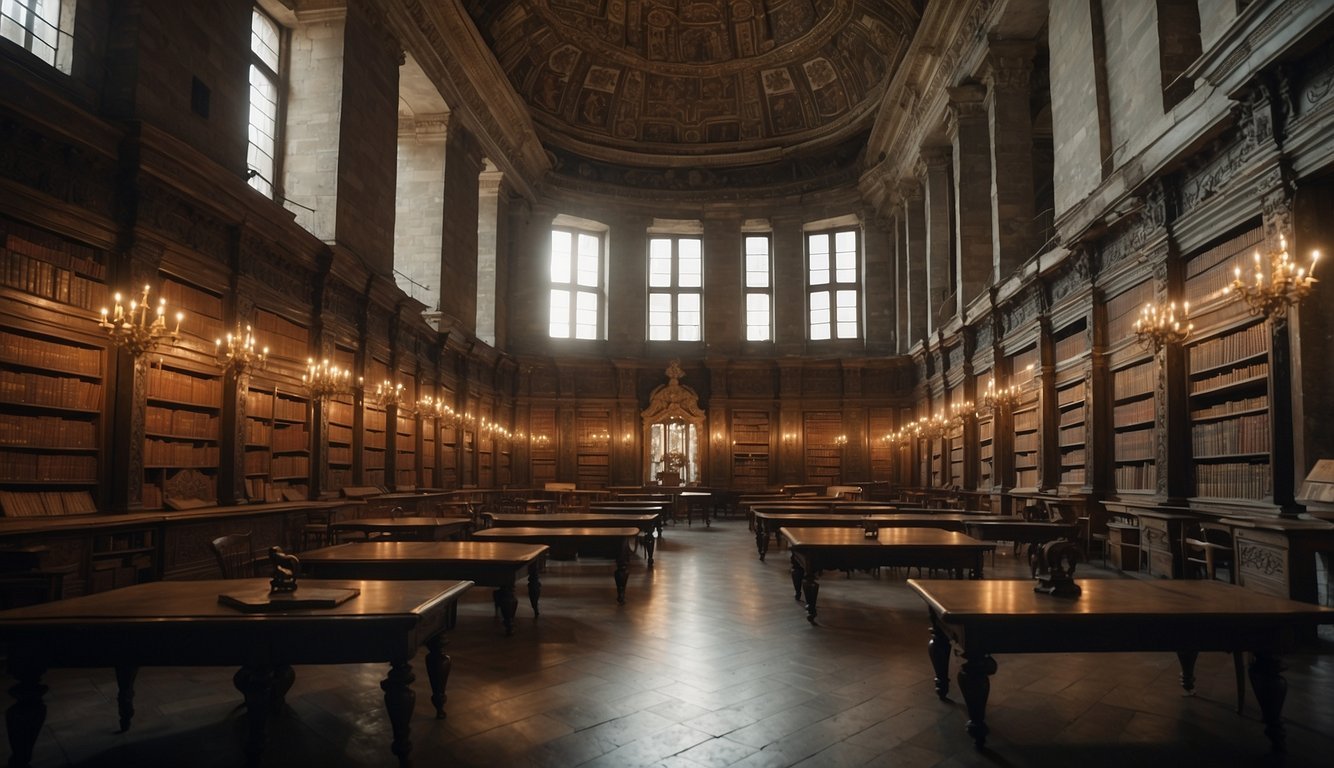The Vatican Library, one of the world’s most enigmatic repositories of knowledge, has long captivated the imagination of scholars, historians, and conspiracy theorists alike. What is hidden in the Mysterious Vatican Library? This article explores the shadowy corridors of this ancient institution, revealing the secrets, treasures, and controversies that make it a beacon of mystery and intrigue. From priceless manuscripts to forbidden texts, the library’s holdings offer a glimpse into centuries of human history, religion, and power, all guarded within the heart of the Vatican City.
The Origins and Evolution of the Vatican Library

The Vatican Library’s story is a testament to the enduring quest for knowledge preservation amid the shifting sands of history and power. Established in the heart of Renaissance Rome, it has grown from a modest collection into a vast archive that mirrors the Catholic Church’s intellectual and spiritual journey. This section delves into the foundational years and transformations that have shaped the library into the mysterious bastion it is today, highlighting how it has adapted to countless historical upheavals while maintaining its aura of secrecy.
Establishment by Pope Sixtus IV

Pope Sixtus IV’s decision to formalize the Vatican Library in 1475 marked a pivotal moment in the history of knowledge dissemination. At the time, the Renaissance was in full swing, and the Church sought to consolidate its intellectual authority by gathering texts from across Europe. Sixtus IV, a former Franciscan friar with a deep appreciation for scholarship, envisioned the library as a center for theological study and humanistic inquiry. He appointed scholars and librarians to curate the collection, which initially comprised donated manuscripts, ancient codices, and works acquired through papal diplomacy.
This initiative was not merely about amassing books; it was a strategic move to counter the Protestant Reformation’s challenges by preserving orthodox Catholic doctrines. The library’s early holdings included rare Greek and Latin texts, many of which were salvaged from the decline of the Byzantine Empire. Over time, this foundation attracted intellectuals like Angelo Poliziano and Johannes Bessarion, who contributed to its growth. The establishment under Sixtus IV set a precedent for secrecy, as access was restricted to trusted clergy and select scholars, fostering the mystique that persists today.
As the library evolved, it became a symbol of papal power, with subsequent popes adding to its collections through conquests and acquisitions. For instance, during the Sack of Constantinople in 1204, many treasures found their way to Rome, enriching the Vatican’s holdings. This period underscores how political events intertwined with intellectual pursuits, making the library a repository not just of knowledge, but of contested histories.
Growth and Expansion Over Centuries

The Vatican Library’s expansion was anything but linear; it mirrored the broader historical currents of Europe, from the Age of Exploration to the Enlightenment. By the 16th century, under Pope Leo X, the library had grown significantly, incorporating works from the New World and the Far East, brought back by explorers and missionaries. This era saw the addition of illustrated manuscripts and early scientific treatises, reflecting the Church’s ambivalent relationship with emerging knowledge.
In the 17th and 18th centuries, popes like Urban VIII and Clement XII invested in architectural expansions, creating the grand halls that house the collections today. These developments were accompanied by cataloging efforts, with librarians employing innovative systems to organize the growing number of volumes. However, this growth was punctuated by challenges, such as the Napoleonic Wars, when French troops looted parts of the library, highlighting its vulnerability.
Despite these setbacks, the library adapted by forging alliances with scholars and institutions worldwide. By the 19th century, it had become a hub for Vatican diplomacy, with popes using its resources to engage in intellectual debates. This evolution not only expanded the physical collection but also deepened the layers of secrecy, as certain sections were designated for exclusive use, fueling speculation about what is hidden in the Mysterious Vatican Library.
Role in Preserving Knowledge
Throughout its history, the Vatican Library has played a crucial role in safeguarding human knowledge, often at great risk. During the Middle Ages, when many texts were lost to wars and neglect, the library served as a refuge for ancient wisdom, preserving works by Aristotle, Plato, and early Christian fathers. This preservation effort was driven by a belief in the divine origin of knowledge, where texts were seen as conduits to understanding God’s creation.
The library’s role extended beyond mere storage; it facilitated scholarly exchanges that influenced art, science, and theology. For example, during the Counter-Reformation, it became a center for censoring heretical works, which added to its secretive nature. Librarians meticulously copied and restored manuscripts, ensuring their survival for future generations. This dedication to preservation has made the Vatican Library an invaluable resource for understanding cultural shifts, such as the transition from manuscript to print culture with the advent of the Gutenberg press.
In modern times, the library continues to preserve knowledge through conservation techniques and international collaborations. Yet, this role is not without controversy, as the selective disclosure of materials raises questions about transparency and control. The preservation efforts underscore the library’s dual identity as both a guardian of history and a gatekeeper of mysteries, perpetuating the intrigue surrounding what is hidden in the Mysterious Vatican Library.
Hidden Gems: Famous Artifacts and Documents

Beneath the vaulted ceilings of the Vatican Library lie treasures that could rewrite history, from ancient scrolls to illuminated masterpieces. These artifacts represent the pinnacle of human creativity and intellect, often shrouded in layers of secrecy that enhance their allure. This section uncovers some of the most renowned items, exploring their significance and the stories they tell about faith, power, and discovery.
The Codex Vaticanus and Biblical Manuscripts
The Codex Vaticanus stands as one of the most celebrated holdings in the Vatican Library, a nearly complete manuscript of the Greek Bible dating back to the 4th century. Discovered in the 15th century, it has been pivotal in biblical scholarship, offering insights into early Christian texts and textual variations. Unlike other codices, it was written in uncial script on vellum, showcasing the meticulous craftsmanship of ancient scribes who labored to copy sacred words with precision.
Scholars debate its origins, with some attributing it to the scriptorium of Alexandria or Caesarea, under the patronage of figures like Emperor Constantine. The codex’s survival through the ages is a miracle, having evaded destruction during invasions and reforms. Its pages contain not only the Old and New Testaments but also apocryphal texts, providing a window into the diverse interpretations of Christianity in antiquity. This artifact exemplifies how the Vatican Library preserves foundational documents that influence religious thought worldwide.
Beyond the Codex Vaticanus, the library houses a plethora of biblical manuscripts, including fragments from the Dead Sea Scrolls and early versions of the Gospels. These documents have fueled theological debates and historical research, revealing how scripture evolved over centuries. The secrecy surrounding access to these items often stems from their potential to challenge established doctrines, adding to the mystique of what is hidden in the Mysterious Vatican Library. Researchers must navigate strict protocols to study them, making each discovery a hard-won triumph.
Rare Incunabula and Early Printed Books
Incunabula, or books printed before 1501, form a critical part of the Vatican Library’s collection, bridging the gap between manuscript culture and the printing press. The library boasts one of the finest assemblages, including copies of Gutenberg’s Bible, which revolutionized the dissemination of knowledge. These early printed works are not just books; they are artifacts that reflect the technological and cultural shifts of the Renaissance.
For instance, the Vatican holds a 42-line Bible printed by Gutenberg, adorned with hand-illuminated initials that blend medieval artistry with innovative printing. Such items highlight the transition from labor-intensive copying to mass production, democratizing access to texts while simultaneously concentrating power in institutions like the Vatican. Scholars study these incunabula to trace the history of typography and illustration, uncovering how they influenced art movements and scientific inquiry.
The rarity of these books is amplified by their condition and provenance. Many were acquired through papal acquisitions or donations from wealthy patrons, and their preservation involves cutting-edge techniques to combat aging and decay. This section of the library often sparks curiosity aboutthe hidden narratives behind these treasures, as incunabula represent not only the evolution of written knowledge but also the socio-political dynamics of their time. Scholars frequently muse over the ideological battles fought within these pages, as various factions vied for control over interpretation and dissemination of information.
Moreover, the study of incunabula offers a glimpse into the early relationship between the church and emerging secular powers. The presence of these texts in the Vatican Library raises questions about censorship, intellectual freedom, and the role of religious institutions in shaping cultural discourse. In this sense, the library functions as a repository of power struggles, where the printed word became both a tool for enlightenment and a weapon of control.
Illuminated Manuscripts: Art and Faith
Illuminated manuscripts found in the Vatican Library are not merely books; they are breathtaking works of art that reflect the interplay between faith and creativity. These meticulously crafted texts feature vibrant illustrations, ornate decorations, and intricate calligraphy that elevate the written word to an art form. The process of creating these manuscripts was labor-intensive and often involved entire teams of artisans, scribes, and illuminators working together in great secrecy.
One notable manuscript is the “Vatican Virgil,” an exquisite copy of Virgil’s works dating back to the 5th century. It is adorned with stunning miniatures depicting mythological scenes and allegories. This manuscript showcases how artistry served as a vehicle for conveying complex ideas, blending classical literature with Christian themes. The illumination not only enhances the aesthetic appeal but also enriches the interpretative possibilities, inviting readers to engage with the text on multiple levels.
The significance of illuminated manuscripts extends beyond their beauty; they provide insights into historical contexts, such as the patronage systems that supported their creation. Many were commissioned by affluent individuals or monasteries seeking to demonstrate piety and wealth. Consequently, the designs and themes reflected societal values and aspirations, making these manuscripts invaluable for understanding cultural phenomena.
In today’s digital age, the conservation of these illuminated manuscripts poses unique challenges. While technology allows for enhanced preservation methods and virtual accessibility, it simultaneously raises concerns about the authenticity of experience. Engaging with these artifacts in person transcends mere observation; it evokes a visceral connection to history and spirituality that cannot be replicated online. As custodians of such artistic heritage, the Vatican Library navigates the delicate balance between preserving these gems and adapting them to contemporary scholarship and appreciation.
The Controversial Access Policy

Access to the Vatican Library has long been a point of contention, raising questions about transparency, exclusivity, and the nature of knowledge in an increasingly globalized world. The library operates under strict protocols that regulate who can enter its hallowed halls and under what conditions. Understanding this controversial access policy sheds light on the motivations behind it and its implications for scholars and the public alike.
Historical Context of Restricted Access
Historically, the Vatican Library’s restricted access is rooted in its dual identity as both a sacred space and an intellectual fortress. Established as a place to safeguard theological texts, it evolved into a site where knowledge was tightly controlled, often in response to political and religious upheavals. The highly selective nature of access reflects the church’s broader efforts to maintain authority over spiritual matters, particularly during times of dissent and reformation.
For many centuries, the papacy wielded considerable influence over intellectual discourse, fearing that unauthorized interpretations could undermine doctrinal teachings. Scholars wishing to study manuscripts were required to obtain special permissions, which inadvertently created an aura of intrigue around the materials housed within. This exclusivity contributed to a narrative suggesting that the Vatican Library harbored secrets that could potentially challenge established beliefs, thereby amplifying interest in what is hidden in the Mysterious Vatican Library.
Modern Restrictions and Scholarly Debate
In recent decades, the Vatican Library has made strides toward democratizing access by opening certain collections to researchers and the public. However, restrictions persist, particularly concerning sensitive documents related to church governance, sexual abuse scandals, or other contentious issues. The selective disclosure can provoke debates among historians and theologians regarding the legitimacy of these practices and the ethical implications of withholding information.
Critics argue that transparency is essential for accountability, especially given the increasing calls for reform within the Catholic Church. The tension between protecting institutional interests and fostering open inquiry raises profound questions about the role of libraries as gatekeepers of knowledge. Proponents of greater accessibility contend that unrestricted access could lead to new discoveries and reinterpretations of historical events, enriching our understanding of faith and culture.
Innovations in Digital Access
As the digital age unfolds, the Vatican Library is beginning to embrace technology as a means to enhance accessibility while safeguarding its treasures. Digitization projects have started to make select manuscripts available online, allowing scholars and enthusiasts from around the world to examine texts that were previously confined to physical archives. This shift sparks intriguing discussions about the future of libraries in a digital landscape.
While digitization democratizes access to knowledge, it also evokes questions regarding authenticity, interpretation, and experience. Scholars express concern that virtual engagement may dilute the richness of interacting with original artifacts in situ. Furthermore, the potential for commercialization or sensationalism surrounding exclusive content raises alarms about the values underpinning scholarly work.
Ultimately, the Vatican Library’s access policies reflect a complex interplay of tradition, authority, and innovation. While restrictions may continue to provoke debate, there is hope that advancements in technology will pave the way for enhanced transparency and collaboration across disciplines. Such developments may contribute to unraveling the layers of mystery surrounding what is hidden in the Mysterious Vatican Library and redefine our relationship with historical texts.
Conclusion
The Vatican Library stands as a monumental institution that encapsulates the essence of human knowledge, creativity, and faith. Its storied history, rich collection of artifacts, and evolving access policies illuminate the complexities of preserving and sharing knowledge in an ever-changing world.
From its crucial role in safeguarding ancient texts to housing some of humanity’s most revered works, the library embodies the duality of being a guardian of history while also serving as a gatekeeper of mysteries. As we continue to explore what is hidden in the Mysterious Vatican Library, it becomes evident that our quest for understanding is intricately tied to the nuances of access, preservation, and interpretation.
As the digital age progresses and the Vatican Library aligns itself with modern technological advancements, we stand on the precipice of new revelations. The potential for unlocking hidden gems, both in terms of artifacts and knowledge, beckons us to engage more deeply with the past. Ultimately, the journey to uncover the secrets of this remarkable library invites us to reflect on our collective memory and the enduring quest for truth.

GIPHY App Key not set. Please check settings